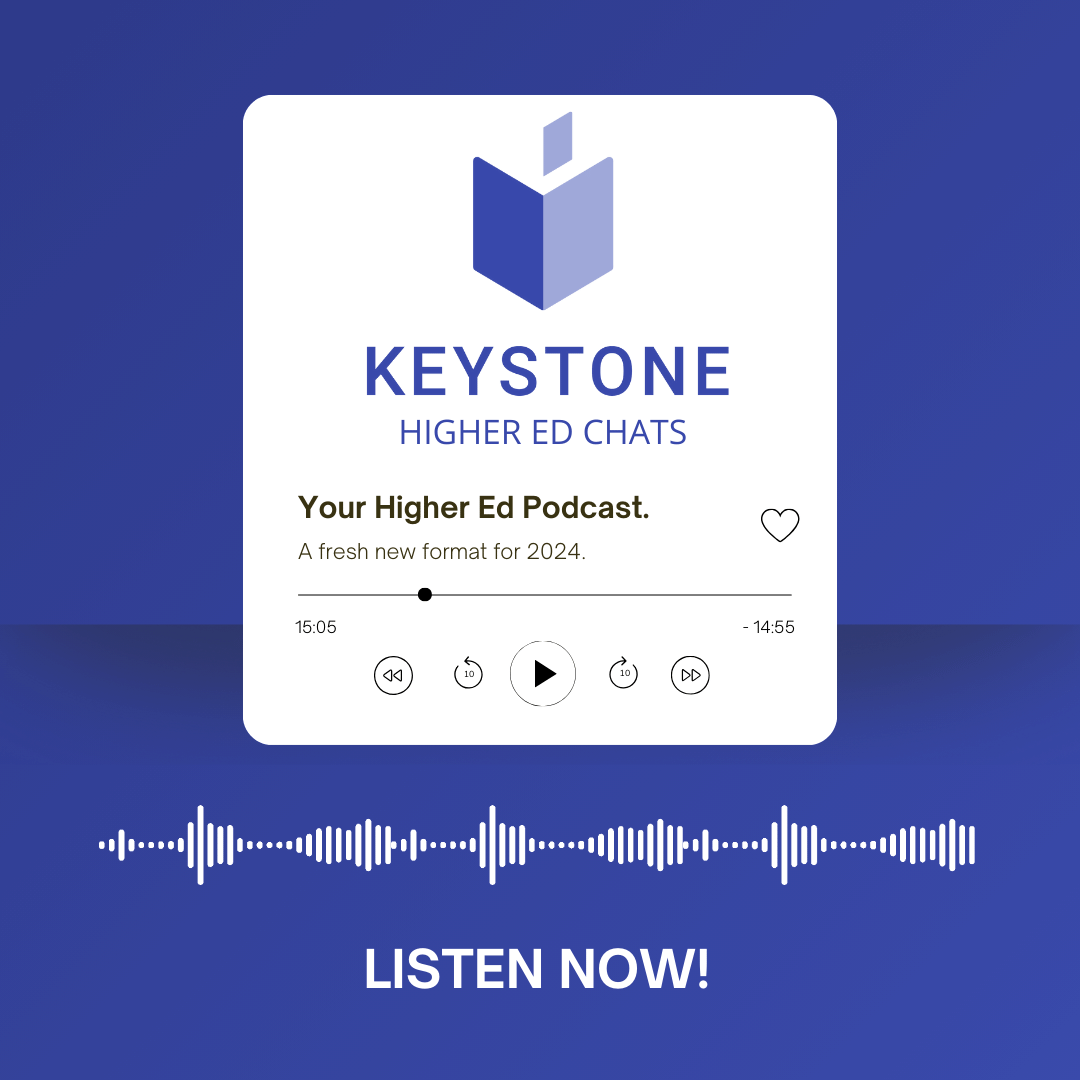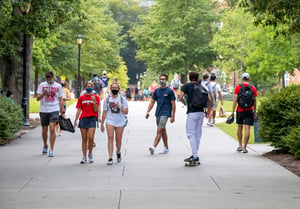- SERVICES
- HIGHER EDUCATION MARKETING
- ENGAGEMENT & ENROLLMENT MANAGEMENT
- STUDENT RECRUITMENT AGENCIES
- PROFESSIONAL EDUCATION & TRAINING
- WHO WE ARE
WHO WE ARE
Learn more about Keystone Education Group, including our leadership structure, why choose Keystone as your educational partner, and company press releases.
QUICK LINKS
- RESOURCES
RESOURCES
Find a range of helpful resources to help with your educational marketing. From on-demand webinars, reports & data, to customer testimonials and our downloadable media kit.
QUICK LINKS
- NEWS
- REQUEST A CALL

- Keystone Higher Education News
- Harmonizing online and on-campus learning
With the world rocked by COVID-19, higher education institutions are still grappling with what the future holds for their students. As countries begin to get a tenuous grasp on controlling the virus, campuses are cautiously beginning to open again. However, there’s still a risk of creating an outbreak by bringing students together, as well as other considerations. Students are holding down jobs, helping out with family, or have other personal issues preventing them from being on campus full time. In order to ease this transition, many institutions are learning how to harmonize online and on-campus learning. While there will certainly be some challenges ahead, there are also many rich opportunities to engage students both online and in person. Here are a few ways your campus could make this a possibility for students, faculty, and staff.
After COVID-19 struck in the end of 2019 and early 2020, many schools hastened to send students home, including their international students. Travel restrictions remained in place, particularly for the United States, making it unknown when or if students could return to their university. When schools attempted to open for the fall 2020 semester, hopes were quickly dashed when the virus spread swiftly through student populations. In response, many schools closed their doors to in person learning, forcing students to move to an online mode of learning.
With many students still remaining at home, flexibility is key in ensuring students can continue their education. Offering smaller, in person opportunities for learning while maintaining a virtual component can ensure students who weren’t able to return to campus can still remain involved. Faculty can offer in person instruction, while simultaneously broadcasting their instruction via platforms such as Zoom. Students who may be under quarantine, or hospitalized should be offered virtual learning, with the option to return to campus when their health permits. If there are areas with clusters of students, creating opportunities for them to gather safely for shared virtual instruction can also help build a sense of community, even if they can’t make it to campus. Finally, adjusting traditional course times may allow for international students, or those with outside responsibilities to continue to attend class while not falling behind.
Different solutions:
If there’s one thing living in a pandemic situation has taught us, it’s that flexibility is key. Additionally, patience and understanding can go a long way, as well as ingenuity. When schools closed, many educators swiftly pivoted to fully online learning. While the speed of which this happened was nothing short of miraculous, it wasn’t entirely smooth for educators or students. Therefore, going forward it’s going to be critical to adapt and be open to finding different solutions to problems as they arise. However, as Paul Hanstedt said in an insidehighered.org article, there is a “silver lining: if nothing else, the global pandemic is breaking the boundary between static university learning and the wicked fluidity of the world.”
What this means is there’s an opportunity to problem solve in new, collaborative ways. Educators and students can work together to figure out what’s best for them, their learning, and how they support each other. Real life is no longer an abstract idea that takes place outside of the classroom, and as a result it can now be incorporated into curriculums. What education looked like has changed significantly, and to keep students engaged, universities have to adapt as well. For example, welcoming students on campus a few days a month, alternating who attends classes on what days, creating small pods or cohorts of students, or allowing students to pick and choose what works for them and their comfort levels will foster a sense of camaraderie.
Outside teaching:
One of the most common images of a university is that of students sitting in a classroom, rapt while the professor instructs from the front of the room. However, COVID-19 has given an opportunity for students and professors to take education outdoors. With the potential for less virus spread to happen outside, going outside of the traditional four walls is a no-brainer. This is a great way to include students who may not be as comfortable inside, but still want to be a part of their cohort. As Craig Strang, the associate director of teaching and learning with Lawrence Hall of Science at the University of California, Berkeley said, “There's also an intrinsic value to being outdoors: it's good for students' social, emotional, and mental well-being, even more so as they return to school after several traumatic months during which tens of thousands of Americans died from a deadly disease.” Where space and weather permits, outdoor learning provides a safer way to allow students to learn and connect.
Practical vs essay based studies:
While many programs require a hands-on, in person model for learning, there are opportunities to shift some of these expectations. Consider allowing students to attend in person events, such as labs, in smaller groups to encourage safety. For students who might be unable to come to these learning opportunities in person, swapping some of the in-person components for other methods can be beneficial. While tests and practicals have been the standard for testing knowledge for many years, allowing students to demonstrate the depth of their knowledge in other ways can still be a strong measure of what they’ve learned. For example, swapping some exams or labs for essay based studies can give students a chance to show what they know, while also fostering transferable skills that will follow them after they leave school.
Other options could include projects, individual or group, that would allow students to gather artifacts of their learning, and showcase them online. There are a variety of softwares, as well as free applications that can make this possible. This is also a great opportunity for students to engage who may be unable to be in person, but still want to participate. When assigning groups, consider which students might be able to work together most successfully to avoid frustration.
Communication:
Finally, communication is key to making a hybrid learning experience successful. Professors should be clear with students about what the expectation of their course is, including when a student needs to be available to participate in person, and what or if the accommodations will be for those who cannot be there. Crafting a course that allows for hybrid learning will be beneficial to many students, but also will need to be clearly communicated to your students so there is no misunderstanding about the course expectations. Additionally, faculty should be willing to make themselves available to students during both virtual and in person office hours when they’re able, to allow students the opportunity to chat, ask questions, and get to know you. During this time, personal connection is crucial for keeping students engaged and on track for completing their degrees.
While the world might still seem uncertain, education is one of the things that many students and faculty can rely on to provide consistency and support. Therefore, it’s up to universities to keep their students engaged by providing them with educational opportunities that work for their rapidly-changing environments and experiences. However, by showing students now that their needs are being heard and met, universities are positioning themselves to help students make a more seamless transition back onto campus full time when it’s safe. Additionally, students who may not have found traditional education possible may benefit from a hybrid schedule, therefore opening the door for further education.
More about:
Related Tags
Just For You
Top Picks
Higher Ed Chats Podcast
Listen to the latest episodes of our Higher Ed Chats Podcast - new format for 2024. Hear from Higher Ed thought-leaders from around the world!

Webinar: Dos & Don'ts of Higher Ed Social Media
.png?width=500&name=Social%20Media%20Webinar%20March%2024%20Banners%20(3).png)
Join our live webinar on 27th March to hear from a panel of Higher Ed Social Media experts.
Subscribe
to get the latest news and updates





